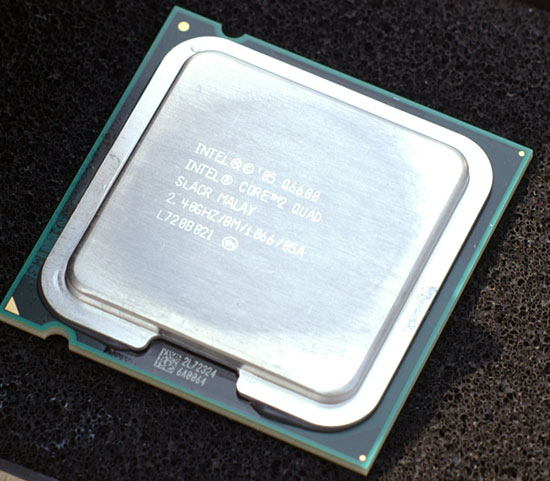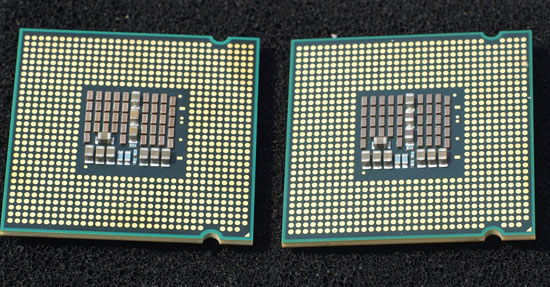Intel Core 2 Q6600 G0 Stepping: Cheap Quad Core Just Got Better
by Anand Lal Shimpi on August 16, 2007 11:53 AM EST- Posted in
- CPUs
Last month's price cuts not only made it tempting to build a new PC today, but they also brought quad-cores within the reach of mid-range budget systems.
| CPU | Clock Speed | FSB | L2 Cache | Availability | Pricing |
| Intel Core 2 Extreme QX6850 | 3.00GHz | 1333 | 4MBx2 | Now | $999 |
| Intel Core 2 Extreme QX6800 | 2.93GHz | 1066 | 4MBx2 | Now | $999 |
| Intel Core 2 Quad Q6700 | 2.66GHz | 1066 | 4MBx2 | Now | $530 |
| Intel Core 2 Quad Q6600 | 2.40GHz | 1066 | 4MBx2 | Now | $266 |
| Intel Core 2 Duo E6850 | 3.00GHz | 1333 | 4MB | Now | $266 |
| Intel Core 2 Duo E6750 | 2.66GHz | 1333 | 4MB | Now | $183 |
| Intel Core 2 Duo E6550 | 2.33GHz | 1333 | 4MB | Now | $163 |
| Intel Core 2 Duo E6540 | 2.33GHz | 1333 | 4MB | Now | $163 |
| Intel Core 2 Duo E4600 | 2.40GHz | 800 | 2MB | Q4 | $133 |
| Intel Core 2 Duo E4500 | 2.20GHz | 800 | 2MB | Q3 | $133 |
| Intel Core 2 Duo E4400 | 2.00GHz | 800 | 2MB | Now | $113 |
| Intel Pentium E2180 | 2.00GHz | 800 | 1MB | Q4 | $84 |
| Intel Pentium E2160 | 1.80GHz | 800 | 1MB | Now | $84 |
| Intel Pentium E2140 | 1.60GHz | 800 | 1MB | Now | $74 |
For $266 you now have a tough decision to make: do you buy two 3.0GHz cores or four 2.40GHz cores? In our last review we found that if you're doing any amount of 3D rendering or media encoding, the Core 2 Quad Q6600 at $266 ends up being the better value. Of course, if you want the best of both worlds you could always overclock the 2.40GHz Q6600, giving you four, much faster cores.
Hitting the S-Spec
In between major architectural revisions of processors, a core will go through multiple revisions or steppings. These steppings can be simple manufacturing tweaks, allowing for cooler operation, or they can include bug fixes and slight performance improvements. Performance improvements are rarely tangible, if even measurable in most cases, but the point is that these cores evolve over time. AMD and Intel learn better, more efficient ways to produce the chips over the lifetime of the processors and they incorporate the learnings into later revisions of the processors.
The original Core 2 processors that launched in July of last year were stepping B1, they were later replaced by a B2 stepping. Intel quietly introduced a new core with only 2MB of L2 cache (instead of 4MB with only half enabled), and thus we gained two more steppings: L2 and M0. The quad-core processors use a slightly different core stepping as well: B3. More recently, Intel introduced yet another revision to its Core 2 microprocessors: the G0 stepping.
G0 fixes a handful of bugs, but most of them were minor and or have software workarounds in play. The more noticeable aspect of G0 is its lower power consumption, which some have proposed as meaning G0 cores may be better overclockers.
Only a subset of Intel processors are presently available with G0 stepping cores: the Core 2 Duo E6540, E6550, E6750, E6850, Q6600, Q6700, QX6800 and QX6850. Of those listed, the E6540, E6550, E6750, E6850 and QX6850 are only available in G0, while the remainder are offered in B2 or B3 as well.
How do you know what stepping you've got? CPU-Z will tell you exactly what you're running, but you can also look at the CPU itself or the box it came in if you've got a retail chip.
Intel encodes the core stepping, cache size, frequency, package, FSB and more into a five character code called an S-Spec. You can use Intel's Processor Finder to decode almost any S-Spec, although there are some limitations.
The new G0 stepping chips have the following S-Specs:
| S-Spec | Core Stepping | CPU |
| SLAFN | G0 | QX6850 |
| SLACP | G0 | QX6800 |
| SLACQ | G0 | Q6700 |
| SLACR | G0 | Q6600 |
| SLAA5 | G0 | E6540 |
| SLA9X | G0 | E6550 |
| SLA9V | G0 | E6750 |
| SLA9U | G0 | E6850 |
Here we have the new G0 based SLACR S-Spec on a processor box:

...and on the Q6600 itself:

Some vendors will even go as far as to hand select only G0 processors, advertising them as such. The question we're here to answer is whether or not the G0 based Q6600, (S-Spec: SLACR), is noticeably better than its B3 predecessor (S-Spec: SL9UM).

The G0 based SLACR (left) and the B3 based SL9UM (right)
Test Configuration
| CPU: | Intel Core 2 Quad Q6600 (2.40GHz/1066MHz) B3 Intel Core 2 Quad Q6600 (2.40GHz/1066MHz) G0 Both chips used the same VID |
| Motherboard: | Gigabyte GA-P35C-DS3R (Intel P35) |
| Chipset: | Intel P35 |
| Chipset Drivers: | Intel 8.1.1.1010 (Intel) |
| Hard Disk: | Seagate 7200.9 300GB SATA |
| Memory: | Corsair XMS2 DDR2-800 4-4-4-12 (1GB x 2) |
| Video Card: | NVIDIA GeForce 8800 GTX |
| Video Drivers: | NVIDIA ForceWare 158.18 |
| Desktop Resolution: | 1600 x 1200 |
| OS: | Windows Vista Ultimate 32-bit |










34 Comments
View All Comments
strikeback03 - Friday, August 17, 2007 - link
...that Newegg shipped me a pair of the B3 stepping ones in the box I opened this morning.Does anyone actually sell these for $266? Cheapest I found seemed to be around $285.
Roy2001 - Friday, August 17, 2007 - link
$266 is price for 1000 units. Since demand is high and there is no competition, retailers would price it higher. Remember how much egg wanted when they restock it? From $299 to $379.ruusnak - Friday, August 17, 2007 - link
Did you measure temperature differences under load? Even when the new stepping draws more power, the Intel spec sheet's temp curves are quite different... does G0 run hotter or cooler in practice?ruusnak - Friday, August 17, 2007 - link
I meant "even if the new stepping draws less power" of course...jay401 - Thursday, August 16, 2007 - link
What's this Intel Resource Center that's now a link at the bottom of the conclusion page next to "Home"? I don't see an AMD Resource Center at the bottom of the concluding page of AMD articles.vijay333 - Thursday, August 16, 2007 - link
Intel ponied up the cash : "This site is presented by Intel" (right on top), while AMD chose not to for some reason...mostlyprudent - Friday, August 17, 2007 - link
Or, it could have something to do with the fact that it's an article about a new stepping of an INTEL chip. This site is so pro Intel that they spent a year or more recommending Athlon X2s as the chips to buy. Must have been a conspiracy so that when the Core 2 was released they could show their true colors.vijay333 - Thursday, August 16, 2007 - link
probably deprecated due to lack of activity...jto168 - Thursday, August 16, 2007 - link
Anand,Is it possible for you to state which Batch # the B3 stepping came from?
I have found that many users with earlier Batches of B3 have found it difficult to overclock it successfully as the thermal throttling usually backs the multiplier down.
brentpresley - Thursday, August 16, 2007 - link
For the record - C2D never shipped on the B1 stepping (it was only available in ES chips). The first OEM and Retail silicon was the B2 stepping.